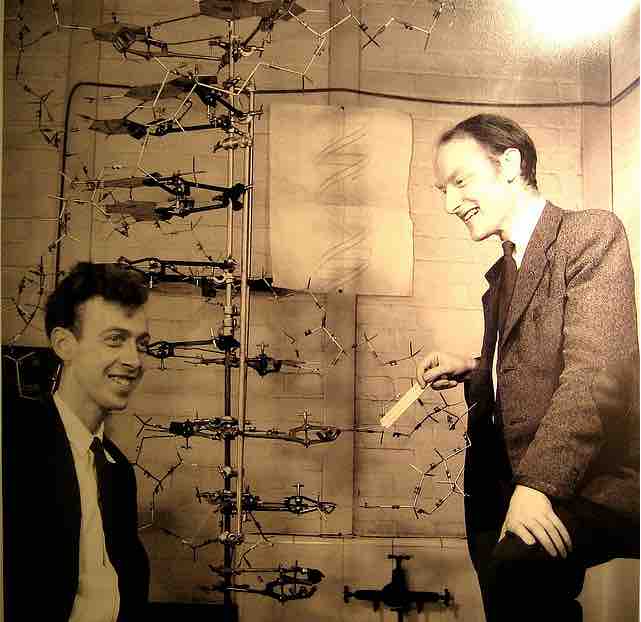Molecular biology attempts to explain the phenomena of life starting from the macromolecular properties that generate them. Two categories of macromolecules are important in molecular biology: 1) nucleic acids, among which the most famous is deoxyribonucleic acid (or DNA), the constituent of genes, and 2) proteins, which are the active agents of living organisms. One definition of the scope of molecular biology therefore is to characterize the structure, function, and relationships between these two types of macromolecules. As such, the study of DNA is a central part of molecular biology.
First Isolation of DNA
In the 19th century, biochemists initially isolated DNA and RNA (mixed together) from cell nuclei. They realized only later that the mixed nucleotides were of two types—one containing ribose (RNA) and the other deoxyribose (DNA).
In 1869, Friedrich Miescher discovered a substance he called "nuclein. " He later isolated a pure sample of the material, which is now known as DNA from the sperm of salmon. In 1889, his pupil, Richard Altmann, named it "nucleic acid. " This substance was found to exist only in the chromosomes.
In 1919, Phoebus Levene identified the components of DNA (the four bases, the 5-carbon sugar, and the phosphate chain) and showed that the they were linked in the order phosphate-sugar-base. He called each of these units a nucleotide and suggested the DNA molecule consisted of a string of nucleotide units linked together through the phosphate groups, which are the 'backbone' of the molecule. Torbjorn Caspersson and Einar Hammersten further showed that DNA was a polymer.
Chromosomes & Inherited Traits
In 1927, Nikolai Koltsov proposed that inherited traits would be inherited via a "giant hereditary molecule" which would be made up of "two mirror strands that would replicate in a semi-conservative fashion using each strand as a template. " Max Delbrück, Nikolai V. Timofeeff-Ressovsky, and Karl G. Zimmer published results in 1935 suggesting that chromosomes were very large molecules which could be changed by treatment with X-rays and that by changing their structure, it was possible to change the heritable characteristics governed by those chromosomes. In 1937, William Astbury produced the first X-ray diffraction patterns from DNA. He was not able to propose the correct structure, but the patterns showed that DNA had a regular structure.
In 1943, Oswald Theodore Avery developed the transforming principle. He identified DNA, and not protein, as the transforming principle. In 1953, Alfred Hershey and Martha Chase did an experiment that showed that DNA is the genetic material.
Finding DNA's Structure
In the 1950s, three groups made it their goal to determine the structure of DNA. The first group to start was at King's College London and was led by Maurice Wilkins and was later joined by Rosalind Franklin. Another group was located in Cambridge and included Francis Crick and James D. Watson. A third group was at Caltech and was led by Linus Pauling . Crick and Watson built physical models using metal rods and balls, in which they incorporated the known chemical structures of the nucleotides, as well as the known position of the linkages joining one nucleotide to the next along the polymer. At King's College Maurice Wilkins and Rosalind Franklin examined X-ray diffraction patterns of DNA fibers. Of the three groups, only the London group was able to produce good quality diffraction patterns and thus, produce sufficient quantitative data about the structure.
Helix Structures
In 1948, Linus Pauling discovered that many proteins included helical shapes from X-ray patterns and from attempts to physically model the structures. Even in the initial diffraction data from DNA produced by Maurice Wilkins, it was evident that the structure involved helices. However, there remained questions of how many strands came together, whether this number was the same for every helix, whether the bases pointed toward the helical axis or away, and ultimately, what were the explicit angles and coordinates of all the bonds and atoms. Such questions motivated the modeling efforts of Francis Watson and James Crick.
The Structure of DNA
In their modeling, Watson and Crick restricted themselves to what they saw as chemically and biologically reasonable. A breakthrough occurred in 1952, when Erwin Chargaff visited Cambridge and inspired Crick with a description of experiments Chargaff had published in 1947. Chargaff had observed that the proportions of the four nucleotides vary between one DNA sample and the next, but that for particular pairs of nucleotides (adenine and thymine, guanine and cytosine) the two nucleotides are always present in equal proportions.
Using X-ray diffraction, as well as data from Rosalind Franklin and her information about base paris, Watson and Crick arrived at the first accurate model of DNA's molecular structure, a double helix, in 1953 .

Structure of DNA
James Watson and Francis Crick are credited with the discovery of the double helix structure of DNA. Linus Pauling and Rosalind Franklin laid the groundwork for their revolutionary discovery.
"Central Dogma"
In 1957, Crick laid out the " Central Dogma, " which explained the relationship between DNA, RNA, and proteins, and articulated the "sequence hypothesis. " A critical confirmation of the replication mechanism that was implied by the double-helical structure followed in 1958 in the form of the Meselson-Stahl experiment. Work by Crick and coworkers showed that the genetic code was based on non-overlapping triplets of bases, called codons, and Har Gobind Khorana and others deciphered the genetic code not long afterwards in 1966. These findings represent the birth of molecular biology.